Advice for Physiotherapy patients following ankle fracture
What is a broken ankle?
A fracture is the same as a break
It normally involves a break to the fibula bone on the outside of your lower leg and can occur below, at the same level or above your ankle joint (see diagram). This may be referred to as a Weber fracture.
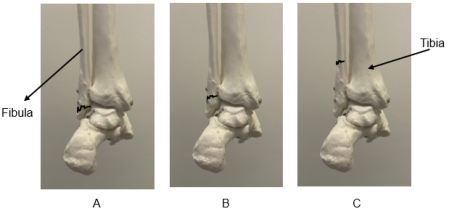
How is it treated?
Plaster of Paris:
Your ankle may need to be manipulated into the correct position first. You will usually be in plaster for approximately four to six weeks.
Surgery
The ends of the bone are usually held in place with pins and plates.
Whilst the plaster is on
It is important to keep your toes and knees moving.
After removal of the plaster
It is normal for your ankle to feel vulnerable once out of the plaster because it hasn’t moved for a long time.
It is important that swelling, pain, strength and stiffness are addressed following the removal of the plaster.
What should I expect when my plaster is taken off, and what can I do?
Pain or discomfort
It is normal to get some pain after your fracture. If you have been given pain killers you should take them as prescribed. This will allow you to do exercises and walk more. Always check instructions or ask your pharmacist or GP about over the counter pain killers. However, if your pain is severe or continuous you should contact your GP.
Swelling
Swelling can reduce your ability to move your ankle and inhibit movement.
Try the following to minimise swelling
- When you are resting, sit with your leg up to elevate your foot.
- At night rest your foot on some pillows so that it lies above the level of your hip.
- An ice pack is very good at helping to reduce swelling. To apply an ice pack; sit with your foot up, wrap a bag of frozen peas in a wet tea-towel and put this onto your ankle. Leave it on for 10-15 minutes. You should check your skin regularly of any sign of ice burns. Your Physiotherapist will advise on how often you should do this.
Stiffness
It is important to try and get as much movement as possible in your ankle after the fracture has healed. Exercising and walking will help to reduce stiffness.
Strength
You will have decreased strength in your ankle because it hasn’t been used while in the plaster. You should gradually increase how much you use your ankle and how much you walk and be guided by your pain.
Please note: Exercise, like medication, requires a specific dose; not enough will be of no benefit, too much may do harm. Only exercise to a comfortable level. Mild discomfort during exercise is acceptable and is normal as long as it settles throughout the day.
Early exercises – Designed to improve movement and function. To be started as soon as your cast is removed and carried out four or five times a day.
Lying o

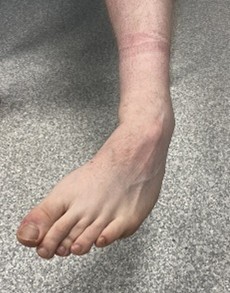
Sitting or lying. Move your ankle around slowly in a large circle. Repeat in the opposite direction.
Repeat 10 times.
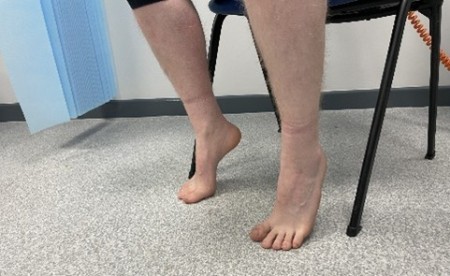
Repeat 10 times.
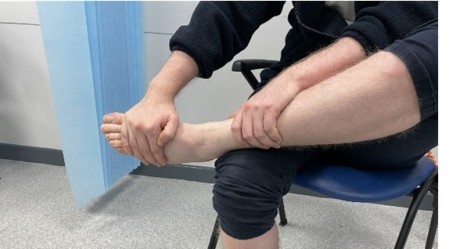
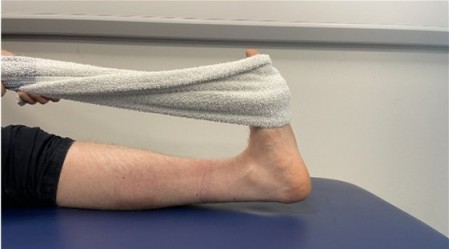
Frequently asked questions (FAQ)
How long will I experience swelling and/or discomfort in my foot/ankle?
Expect swelling/discomfort for up to one year post fracture. This is normal and does not mean there is anything to worry about.
Why does my ankle look a funny shape?
As a fracture heals new bone is formed which will join the broken ends together. This can result in a lump forming in one side of your ankle. This is normal and will take place over 12-18 months.
When can I start driving?
When you have sufficient movement and strength to be able to control the pedals and feel that you could perform an emergency stop safely. This will vary between individuals but approximately six to eight weeks after removal of the plaster. Please make sure you speak to your insurance company.
Should I stop the exercises if my ankle swells or aches?
It is normal to expect some increase in swelling and soreness when doing exercises. Use your pain medication if necessary to enable you to perform the exercises.
How will I know when I can walk without my crutches?
Your consultant will tell you whether you are allowed to put weight through your foot when your cast is removed. After this period you can begin to gradually put more weight through your foot as pain allows.
George Eliot Hospital is a smoke free environment. For help and advice to stop smoking you can call the national helpline on 0300 123 1044 or visit https://
Copyright
Except where otherwise noted, this item is licensed under the CC BY license (https://
If you are a rights holder and are concerned that you have found material on our patient information resources website, for which you have not given permission, or is not covered by a limitation or exception in national law, please contact us using the Feedback form providing your contact information and full details of the material.